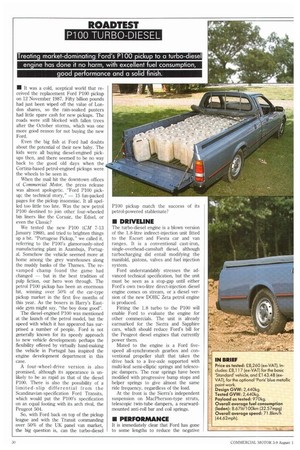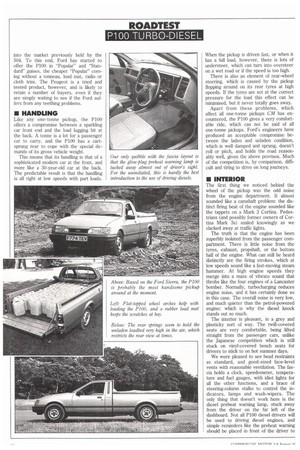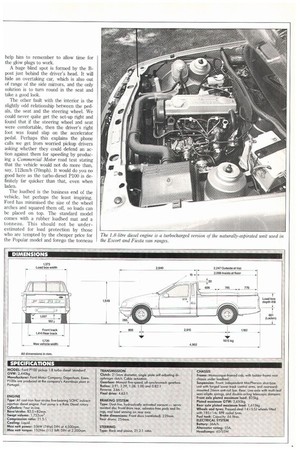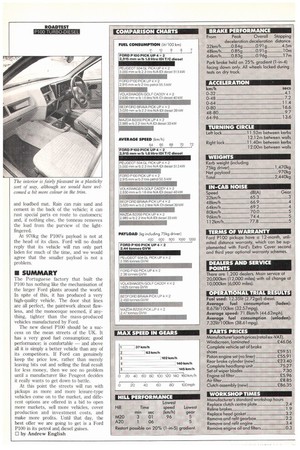Treating market-dominating Ford's P100 pickup to a turbo-diesel engine has
Page 32

Page 33

Page 34

Page 35

Page 36

If you've noticed an error in this article please click here to report it so we can fix it.
done it no harm, with excellent fuel consumption, good performance and a solid finish.
• It was a cold, sceptical world that received the replacement Ford P100 pickup on 12 November 1987. Fifty billion pounds had just been wiped off the value of London shares, so the rain-soaked punters had little spare cash for new pickups. The roads were still blocked with fallen trees after the October storms, which was one more good reason for not buying the new Ford.
Even the big fish at Ford had doubts about the potential of their new baby. The kids were all buying diesel-engined pickups then, and there seemed to be no way back to the good old days when the Cortina-based petrol-engined pickups were the wheels to be seen in.
When the mail hit the downtown offices of Commercial Motor, the press release was almost apologetic. "Ford P100 pickup; the technical story," — 15 fun-packed pages for the pickup insomniac. It all spelled too little too late. Was the new petrol P100 destined to join other four-wheeled bin liners like the Corsair, the Edsel, or even the Classic?
We tested the new P100 (CM 7-13 January 1988), and tried to brighten things up a bit. "Portugese Pickup," we called it, referring to the P100's glamorously-sited manufacturing plant in Azambuja, Portugal. Somehow the vehicle seemed more at home among the grey warehouses along the muddy banks of the Thames. The revamped champ found the game had
changed but in the best tradition of pulp fiction, our hero won through. The petrol MOO pickup has been an enormous hit, winning over 50% of the car-type pickup market in the first five months of this year. As the boxers in Harry's Eastside gym might say, "the boy done good".
The diesel-engined P100 was mentioned at the launch of the petrol model, but the speed with which it has appeared has surprised a number of people. Ford is not generally known for its speedy approach to new vehicle development: perhaps the flexibility offered by virtually hand-making the vehicle in Portugal has inspired the engine development department in this case.
A four-wheel-drive version is also promised, although its appearance is unlikely to be as rapid as that of the diesel P100. There is also the possibility of a limited-slip differential from the Scandinavian-specification Ford Transits, which would put the P100's specification on an equal footing with its arch rival, the Peugeot 504.
So, with Ford back on top of the pickup league and with the Transit commanding over 50% of the UK panel van market, the big question is, can the turbo-diesel P100 pickup match the success of its petrol-powered stablemate?
• DRIVELINE
The turbo-diesel engine is a blown version of the 1.8-litre indirect-injection unit fitted to the Escort and Fiesta car and van ranges. It is a conventional cast-iron, single-overhead-camshaft diesel, although turbocharging did entail modifying the manifold, pistons, valves and fuel injection system.
Ford understandably stresses the advanced technical specification, but the unit must be seen as a stop-gap until either Ford's own two-litre direct-injection diesel engine comes on stream, or a diesel version of the new DOHC Zeta petrol engine is produced.
Fitting the 1.8 turbo to the P100 will enable Ford to evaluate the engine for other commercials. The unit is already earmarked for the Sierra and Sapphire cars, which should reduce Ford's bill for the Peugeot diesel engines that currently power them.
Mated to the engine is a Ford fivespeed all-synchromesh gearbox and conventional propeller shaft that takes the drive back to a live-axle supported with multi-leaf semi-elliptic springs and telescopic dampers. The rear springs have been modified with progressive bump stops and helper springs to give almost the same ride frequency, regardless of the load.
At the front is the Sierra's independent suspension on MacPherson-type struts, telescopic twin-tube dampers, a rearwardmounted anti-roll bar and coil springs.
• PERFORMANCE
It is immediately clear that Ford has gone to some lengths to reduce the negative effects of turbocharging by making sure the boost comes in at low revs and there is little turbo lag. When unladen, the performance delivery is very smooth and surprisingly quick. Top revs are best avoided by those interested in making progress rather than making noises and wearing out the engine quickly, but there is more than enough urge down the power curve to make the raucous top end easy to avoid. When laden the pickup is not exact13 a boy racer, but it does have enough performance to attack a Citroen 2CV with gusto. However, early engagement of fifth gear can leave the performance as flat as a run-down hedgehog, so the well-spaded gears have to be used carefully.
As the turbo boost extends itself to all but the lowest basements of the rev range, there seems to always be sufficient power to pull the vehicle out of trouble. This unfortunately tends to encourage the illusion that there is a powerful naturallyaspirated engine under the hood, and when starting off from rest the throttle has to be pressed quite hard to keep the power on. Otherwise, the P100 could be left gasping for breath in front of oncoming traffic at roundabouts. It would lurch drunkenly out in front of a fastapproaching vehicle, while the desperate driver, with his foot to the floor, would discover that at very low revs the P100 is, in effect, only equipped with a lowpowered naturally-aspirated 1.8-litre diesel.
The gearbox provides all that one would expect of a Ford item, matching short and light lever throws with well-spaced ratios that allow very relaxed cruis
--0, ing, if undistinguished hill restarting ability. Ford told us that our P100 was not a fully-fledged press-fleet vehicle, and that it had been rushed to us soon after the vehicle's launch, so its sluggishness should be taken into account. Likewise with the vehicle's economy, there may be room for improvement here, although it acquitted itself well enough round our light van test route with 8.671it/100km (32.57mpg) despite a slightly revised route which includes an extra hill, making the figure all the more creditable. This means that the Ford has beaten its closest rival, the Peugeot 504, as well as the Bedford Brava, and the Mazda B2200 in the fuel consumption stakes. Only the Volkswagen Caddy has a better fuel consumption in our comparison tables, and the Caddy will soon be joined in Volkswagen showrooms round the UK by the Toyota Hi Lux pickup, badged as a Volkswagen and selling as a Taro. Whether the Caddy will still be offered as well is not known at the moment.
Ford will be pleased to have beaten the Peugeot in the economy stakes, as the company is pitching the diesel P100 right into the market previously held by the 504. To this end, Ford has started to offer the P100 in "Popular" and "Standard" guises, the cheaper "Popular" coming without a tonneau, load mat, radio or cloth trim. The Peugeot is a tried and tested product, however, and is likely to retain a number of buyers, even if they are simply waiting to see if the Ford suffers from any teething problems.
• HANDLING
Like any one-tonne pickup, the P100 offers a compromise between a sparkling car front end and the load lugging bit at the back. A tonne is a lot for a passenger car to carry, and the P100 has a cartsprung rear to cope with the special demands of its gross vehicle weight.
This means that its handling is that of a sophisticated modern car at the front, and more like a 30-year-old car at the back. The predictable result is that the handling is all right at low speeds with part loads. Our only quibble with the fascia layout is that the glow-plug preheat warning lamp is tucked away almost out of driver's sight. For the uninitiated, this is hardly the best introduction to the use of driving diesels. When the pickup is driven fast, or when it has a full load, however, there is lots of understeer, which can turn into oversteer on a wet road or if the speed is too high.
There is also an element of rear-wheel steering, which is caused by the pickup flopping around on its rear tyres at high speeds. If the tyres are set at the correct pressure for the load this effect can be minimised, but it never totally goes away.
Apart from these problems, which affect all one-tonne pickups CM has encountered, the P100 gives a very comfortable ride, which can not be said of all one-tonne pickups. Ford's engineers have produced an acceptable compromise between the laden and unladen condition, which is well damped and sprung, doesn't roll or pitch, and holds the road reasonably well, given the above provisos. Much of the competition is, by comparison, difficult and tiring to drive on long journeys.
• INTERIOR
The first thing we noticed behind the wheel of the pickup was the odd noise from the engine department. It almost sounded like a camshaft problem: the distinct firing beat of the engine sounded like the tappets on a Mark 3 Cortina. Pedestrians (and possibly former owners of Cortina Mark 3s) smiled knowingly as we clacked away at traffic lights.
The truth is that the engine has been superbly isolated from the passenger compartment. There is little noise from the tyres, exhaust, propshaft, or the bottom half of the engine. What can still be heard distinctly are the firing strokes, which at low speeds sound like a fast-moving steam hammer. At high engine speeds they merge into a mass of vibrato sound that throbs like the four engines of a Lancaster bomber. Normally, turbocharging reduces engine noise, and it has certainly done so in this case. The overall noise is very low, and much quieter than the petrol-powered engine; which is why the diesel knock stands out so much.
The interior is pleasant, in a grey and plasticky sort of way. The twill-covered seats are very comfortable, being lifted straight from the passenger cars, unlike the Japanese competition which is still stuck on vinyl-covered bench seats for drivers to stick to on hot summer days.
We were pleased to see head restraints as standard, and good-sized face-level vents with reasonable ventilation. The fascia holds a clock, speedometer, temperature and fuel gauges, with idiot lights for all the other functions, and a brace of steering-column stalks to control the indicators, lamps and wash-wipers. The only thing that doesn't work here is the diesel preheat warning lamp, stuck away from the driver on the far left of the dashboard. Not all P100 diesel drivers will be used to driving diesel engines, and simple reminders like the preheat warning should be placed in front of the driver to help him to remember to allow time for the glow plugs to work.
A huge blind spot is formed by the Bpost just behind the driver's head. It will hide an overtaking car, which is also out of range of the side mirrors, and the only solution is to turn round in the seat and take a good look.
The other fault with the interior is the slightly odd relationship between the pedals, the seat and the steering wheel. We could never quite get the set-up right and found that if the steering wheel and seat were comfortable, then the driver's right foot was found slap on the accelerator pedal. Perhaps this explains the phone calls we get from worried pickup drivers asking whether they could defend an action against them for speeding by producing a Commercial Motor road test stating that the vehicle would not do more than, say, 112km/h (70mph), It would do you no good here as the turbo-diesel P100 is definitely far far quicker than that, even when laden.
The loadbed is the business end of the vehicle, but perhaps the least inspiring. Ford has minimised the size of the wheel arches and squared them off, so loads can be placed on top. The standard model comes with a rubber loadbed mat and a tonneau. This should not be underestimated for load protection by those who are tempted by the cheaper price for the Popular model and forego the tonneau and loadbed mat. Rain can ruin sand and cement in the back of the vehicle; it can rust special parts en route to customers: and, if nothing else, the tonneau removes the load from the purview of the lightfingered.
At 970kg the P100's payload is not at the head of its class. Ford will no doubt reply that its vehicle will run only part laden for much of the time, and we would agree that the smaller payload is not a problem.
• SUMMARY
The Portuguese factory that built the P100 has nothing like the mechanisation of the larger Ford plants around the world. In spite of this, it has produced a very high-quality vehicle. The door shut lines are all perfect, the paintwork almost flawless, and the rnonocoque seemed, if anything, tighter than the mass-produced vehicles manufactured by Ford.
The new diesel P100 should be a success on the mean streets of the UK. It has a very good fuel consumption; good performance; is comfortable and above all it is simply a better vehicle than any of its competitors. If Ford can genuinely keep the price low, rather than merely leaving bits out and selling the final result for less money, then we see no problem until a manufacturer like Peugeot decides it really wants to get down to battle.
At this point the streets will run with pickups as more and more leisure-type vehicles come on to the market, and different options are offered in a bid to open more markets, sell more vehicles, cover production and investment costs, and make more profits. Until that day, the best offer we are going to get is a Ford P100 in its petrol and, diesel guises.
1:1 by Andrew English




































































































